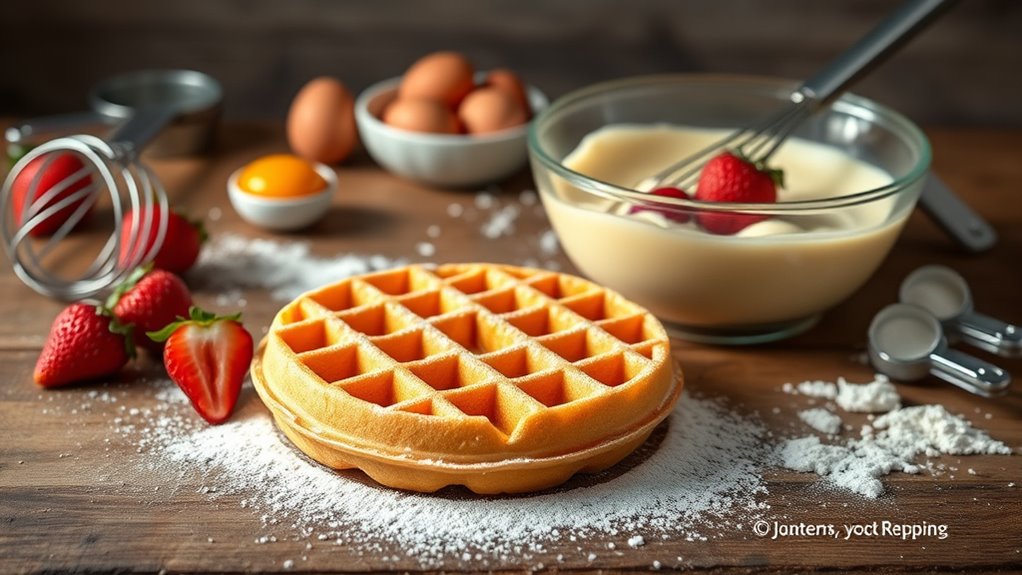To master traditional Belgian waffles, start by gathering key ingredients like all-purpose flour, eggs, sugar, baking powder, and milk. Preheat and lightly grease your waffle iron. Whisk dry and wet ingredients separately, then combine gently to avoid overmixing. Pour batter evenly, cook until golden and crisp, about 4-5 minutes. Serve with fresh berries, syrup, or nuts for texture. Stick to these steps, and you’ll soon impress yourself with perfect Belgian waffles every time. There’s more to explore on technique and toppings that elevate your waffle game.
Ingredients and Quantity
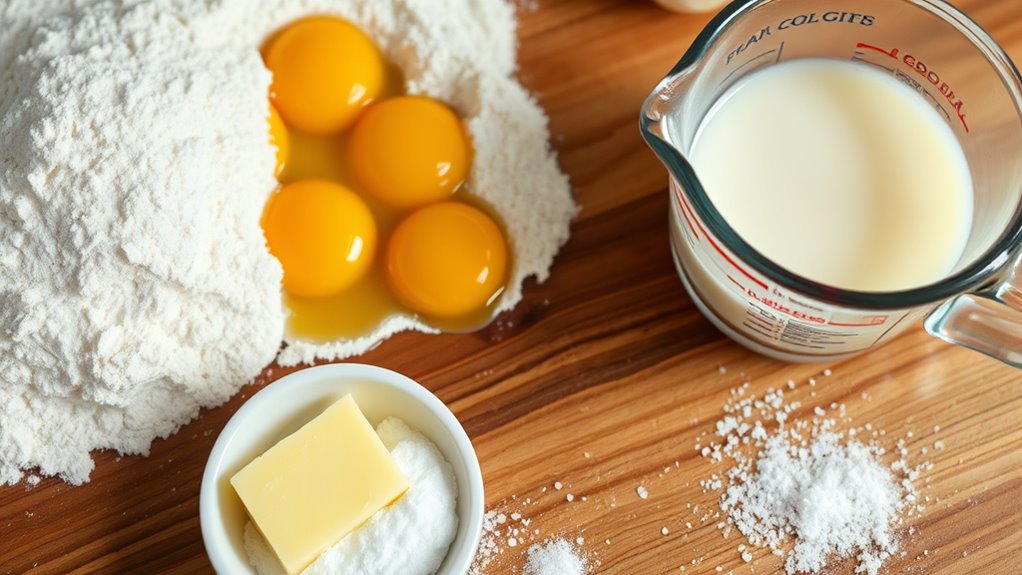
Before you begin mixing, make sure you’ve gathered all the ingredients in the exact quantities specified. Precision here allows you to explore waffle variations and ingredient substitutions confidently, ensuring consistent results. Here’s a clear guide:
| Ingredient | Quantity | Notes |
|---|---|---|
| All-purpose flour | 2 cups | Substitute gluten-free flour |
| Baking powder | 2 tsp | Use baking soda + cream of tartar |
| Sugar | 2 tbsp | Honey or maple syrup possible |
| Eggs | 2 large | Flaxseed egg for vegan option |
| Milk | 1 ¾ cups | Almond or oat milk works well |
Stick to these measurements to maintain the waffle’s texture and rise, but feel free to adapt based on dietary needs or flavor preferences without losing your freedom in the kitchen.
Preparations
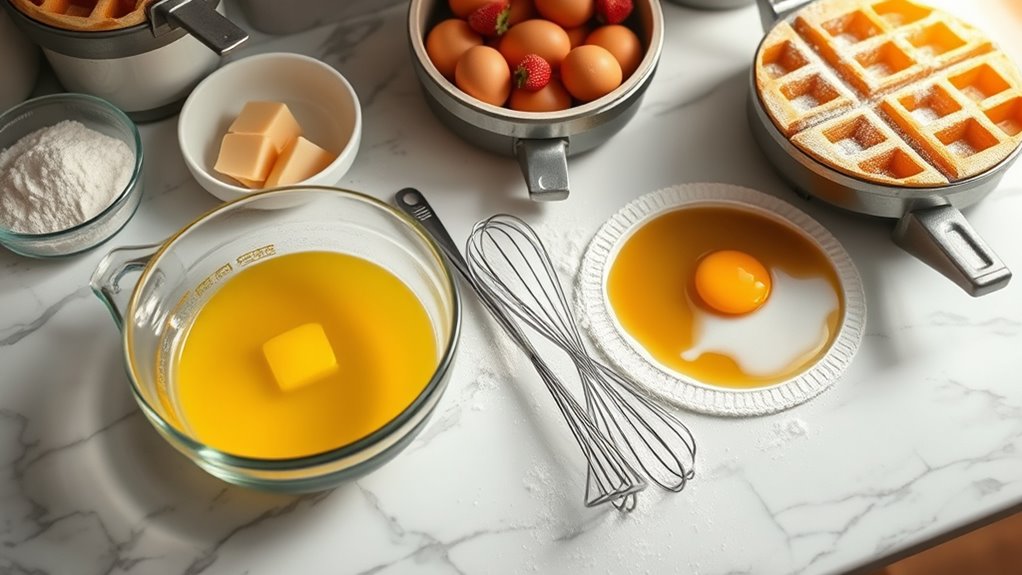
Once you’ve measured all your ingredients accurately, make certain your waffle iron is preheated to the correct temperature to guarantee even cooking. Understanding the waffle history helps appreciate why precise preparation matters—Belgian waffles require a light, airy batter, different from other variations. Whisk wet and dry ingredients separately before combining them gently; overmixing can deflate the batter, compromising texture. Consider batter variations: yeast-based for authentic crispness or baking powder for quicker results. Let the batter rest briefly to activate leavening agents and facilitate uniform rising. Keep your workspace organized and ingredients at room temperature to avoid temperature shocks that affect batter consistency. By following these preparation steps meticulously, you’ll open the freedom to create perfect, traditional Belgian waffles every time, honoring their rich culinary heritage.
Tools / Kitchenware Required
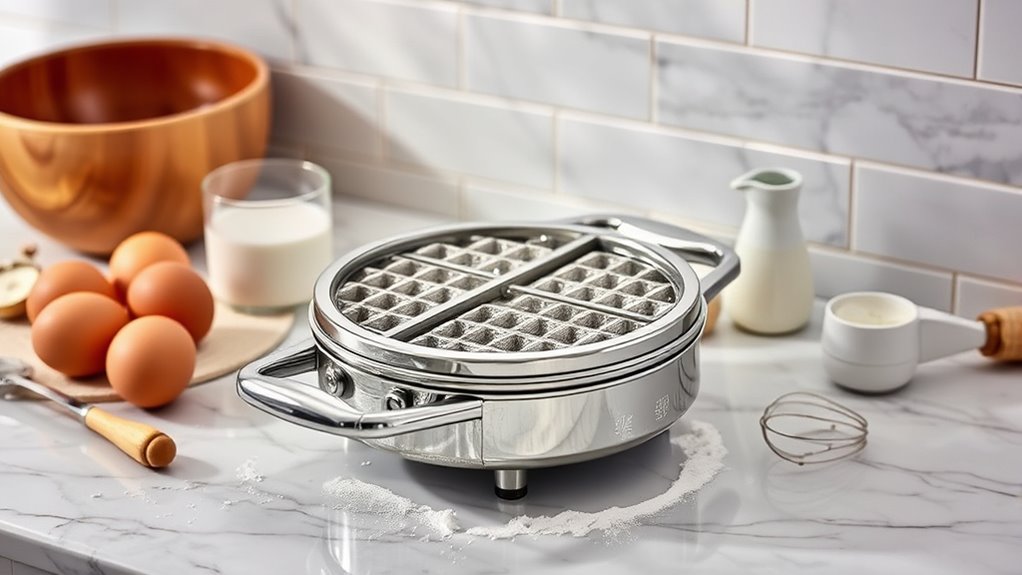
Three essential tools you’ll need to master Belgian waffles include a reliable waffle iron, a large mixing bowl, and a whisk or electric mixer. Your waffle iron should have adjustable temperature settings for consistent results. Sturdy mixing bowls with ample space let you combine ingredients without spills. A whisk or electric mixer guarantees a smooth batter, free of lumps.
| Tool | Purpose |
|---|---|
| Waffle Iron | Cooks waffles evenly, crisp texture |
| Large Mixing Bowl | Mixes ingredients thoroughly |
| Whisk/Electric Mixer | Blends batter smoothly |
| Measuring Cups | Accurate ingredient measurement |
| Spatula | Removes waffles without damage |
Equip yourself with these tools to embrace the freedom of perfect homemade Belgian waffles every time.
How to Cook
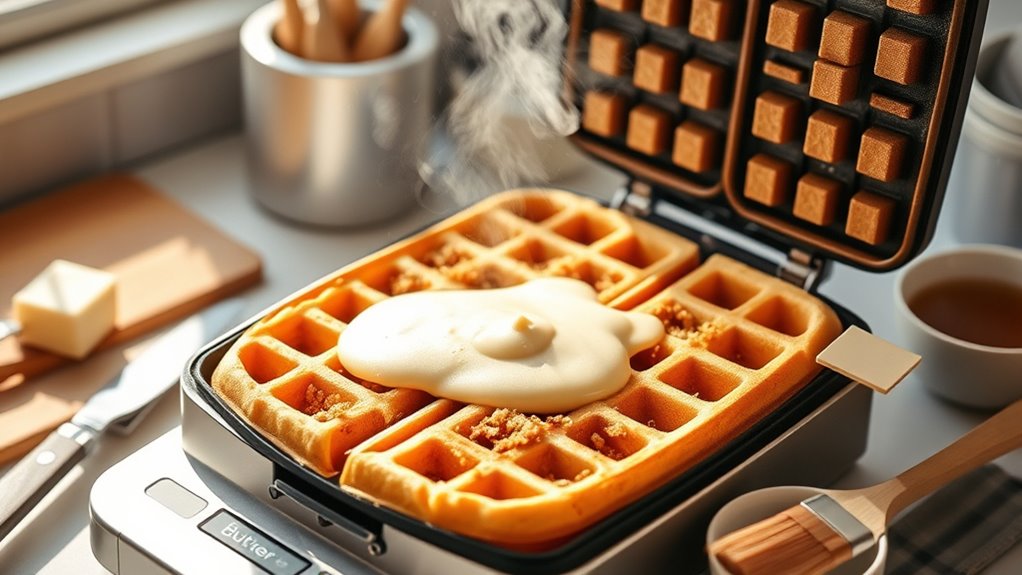
- Preheat your waffle iron thoroughly—typically to medium-high heat—to guarantee even cooking.
- Lightly grease the iron with oil or butter to prevent sticking.
- Pour the batter evenly, avoiding overfilling to allow room for expansion.
- Close the lid gently and cook for 4-5 minutes, or until steam diminishes and the waffle turns golden brown.
- Experiment with cooking techniques, like adjusting heat or cook time, to suit different waffle variations, such as Liege or Brussels styles.
- Observe texture and doneness carefully, then tweak your approach for mastery.
- Use this precision to create waffles exactly how you enjoy them.
How to Serve
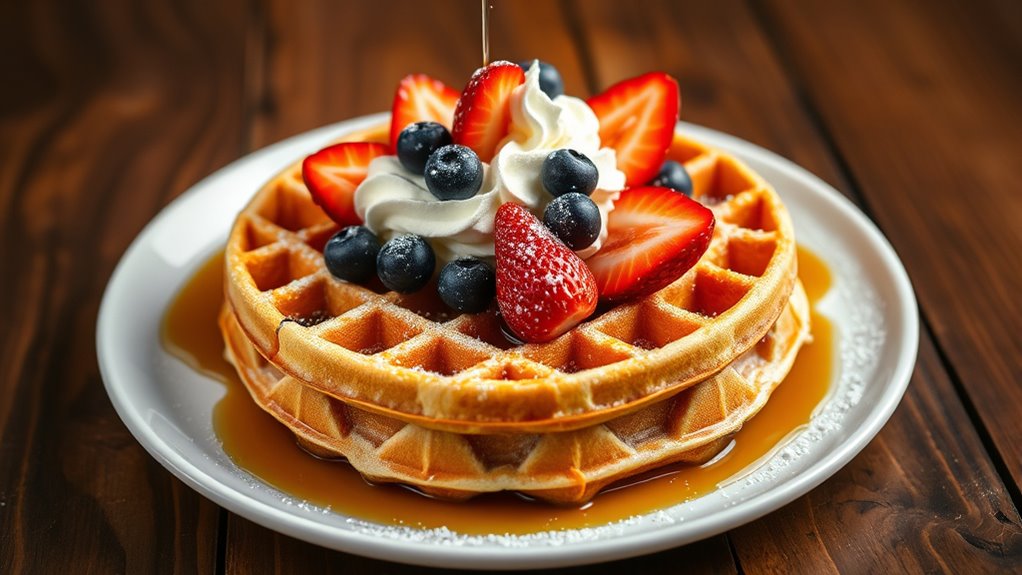
After perfecting your cooking technique, attention shifts to serving your Belgian waffles in a way that enhances their flavor and presentation. To maximize enjoyment, consider these steps:
- Choose your topping suggestions wisely—fresh berries, whipped cream, or a drizzle of pure maple syrup each complement the waffle’s texture and taste.
- Explore serving styles—stack waffles for a layered effect or serve them open-faced to showcase toppings vividly.
- Balance textures and flavors by adding a sprinkle of powdered sugar or a handful of chopped nuts, providing contrast to the waffle’s crispness.
Tips
When aiming for the perfect Belgian waffle, you’ll want to pay close attention to batter consistency and cooking temperature, as both greatly impact texture and doneness. Use a batter that’s thick enough to hold shape but still pourable for even cooking. Preheat your waffle iron fully to guarantee a crispy exterior without sticking. Resist opening the iron too soon; premature lifting can cause uneven cooking. Mastering specific cooking techniques, like brushing the iron with melted butter before each batch, helps achieve a golden crust. For freedom in flavor, experiment with waffle toppings—fresh berries, whipped cream, or even savory options like smoked salmon. By controlling these details, you’ll consistently produce waffles that are light, crisp, and tailored perfectly to your taste.
Food Value and Benefit
Belgian waffles, when prepared thoughtfully, offer a balanced source of carbohydrates, protein, and healthy fats, making them a satisfying and energizing dish. The recipe can be tailored to enhance its nutritional value by incorporating nutrient-rich ingredients.
Thoughtfully made Belgian waffles provide balanced carbs, protein, and healthy fats for a satisfying, energizing meal.
Food Value of Prepared Belgian Waffles:
- Rich in carbohydrates providing a quick source of energy.
- Contains protein from ingredients like eggs, milk, or added Greek yogurt.
- Provides dietary fiber when made with whole grain or alternative flours.
- Contains healthy fats from nuts or added oils.
Vitamins and Minerals in Belgian Waffles:
- Vitamin B complex (especially B2 and B3) from flour and eggs, which supports energy metabolism.
- Calcium from milk or yogurt, important for bone health.
- Iron from whole grain flours, contributing to oxygen transport in the blood.
- Magnesium and potassium from nuts or whole grains, supporting muscle function and heart health.
Benefits of Eating This Recipe:
- Provides sustained energy release due to fiber-rich whole grains.
- Supports muscle repair and growth with its moderate protein content.
- Aids digestion through dietary fiber.
- Supplies essential vitamins and minerals that support overall health and metabolic functions.
- Can be customized to reduce added sugars, making it a balanced treat.
Frequently Asked Questions
Can I Make Belgian Waffles Gluten-Free?
You absolutely can make Belgian waffles gluten-free! Think of gluten-free flour as your magic wand that transforms the classic batter into a free-from delight. Swap regular flour with a blend of gluten-free flour for fluffy, crisp waffles. Be sure to measure carefully, and add your favorite waffle toppings like fresh berries, whipped cream, or maple syrup to elevate the experience. This way, you enjoy freedom without missing a bite of tradition.
How Long Can I Store Leftover Waffles?
You can store leftover waffles in an airtight container or freezer bag for up to 2 days at room temperature, but for longer waffle storage, freeze them for up to 3 months. To keep them crispy, separate each waffle with parchment paper before freezing. When reheating, toast or warm in the oven for best texture. These leftover tips help you enjoy waffles anytime without sacrificing quality or freedom to eat at your pace.
What Is the Origin of Belgian Waffles?
Belgian waffles originated in Belgium during the Middle Ages, with a history analysis revealing their evolution from simple iron-cooked batter to the airy, thick waffles you know. They’re culturally significant, symbolizing Belgian culinary artistry and hospitality. When you appreciate their origin, you connect with a tradition that values freedom in flavor and texture. Understanding this history lets you honor the waffles’ rich past while experimenting confidently with your own variations.
Can I Freeze Belgian Waffles for Later Use?
You’d think waffles are best fresh, but you can absolutely freeze Belgian waffles for later use! Just let them cool completely, then use freezing techniques like wrapping each waffle individually in plastic wrap and placing them in an airtight container or freezer bag. When you’re ready, use reheating methods like toasting or oven baking at 350°F for 5-10 minutes to regain that crispy, fluffy texture. This way, you keep your freedom to enjoy waffles anytime!
Are Belgian Waffles Suitable for Vegan Diets?
Belgian waffles aren’t inherently vegan, but you can easily make them suitable by using vegan substitutions like plant-based milk, flaxseed eggs, and dairy-free butter. Swap traditional toppings for plant-based toppings such as fresh berries, maple syrup, or coconut yogurt. By making these simple changes, you’re free to enjoy delicious waffles without compromising your vegan lifestyle, ensuring both flavor and ethics align perfectly.
